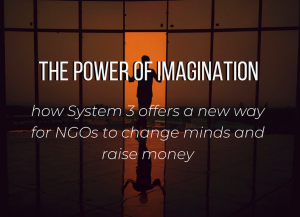

I’d like you to start this article by imagining a different world. Imagine the planet, and the society, you’d like to be living in – is it different to the one we inhabit right now? How does it make you feel to picture that new world?
What your mind is doing right now, as it creates the outline of a possible world, is the key to a major scientific breakthrough. A new development in behavioural science is starting to shape how market research will be done in the coming years. This emerging field brings together how people imagine the future, how they empathize with others and how they plan out their choices. All of these processes take place using brain functions separate from the “System 1 and 2” model that is often used to describe immediate decision-making: it has therefore been labelled System 3.
We live in a world where the attitudes and beliefs of the public are in greater focus, and at greater question, than ever before. Five years ago many of us (including me) assumed the arc of human politics and society was bending towards greater compassion, inclusion, equality and understanding. Now we are not so sure.
In some ways, this moment brings new urgency to the role of NGOs in the public conversation. Climate change presents an immediate and obvious priority; many dimensions of inequality have come into sharp clarity in this political environment; an increase in conflict-driven migration has created new tensions in Europe and North America; and the environmental, welfare and development campaigns that have animated global charity work for decades continue to matter just as much.
A personal example: I support a small charity that helps immigration detainees in the UK. AVID provides resources and advice to volunteers who visit asylum applicants and other migrants during the long periods of detention while a decision is made on whether they can stay in the UK. In the last ten years, AVID has faced the tough challenge of unsympathetic public opinion and media narratives. Between the Brexit referendum and recent UK election results, it could feel as if charities like this are fighting a hopeless battle.
If you work in an NGO that campaigns to influence public views, a new tool to change minds might be very useful around now. And if your job is to raise money, you might also be seeking something to strengthen your case. Fortunately, a new area of behavioural science may offer exactly what you need.
Many readers will know of the behavioural science work that has become prominent in recent years. Summarised in Kahneman’s Thinking Fast and Slow and Thaler & Sunstein’s Nudge, the behavioural economics world tells us about human “irrationality”, cognitive biases, and how to influence decisions in-the-moment. Researchers have responded by incorporating implicit testing into their research approaches to understand respondents’ unconscious thinking. New nudges have been designed: anchoring techniques to increase donations and opt-out defaults to change behaviour.
These approaches are good for influencing what people do, but they barely affect what people think or how they feel. Lasting impact requires changing minds, not just behaviour. In the last ten years a new body of scientific research has emerged to fill this gap.
Psychologists have explored prospection, the capability of humans to imagine and plan the future. They have investigated mental simulation, which allows us to think about the alternative outcomes our choices might bring about, and the different worlds we could possibly live in. Neuroscientists have discovered the default mode network, a set of systems in the brain that are activated when our minds are not focused on immediate tasks – for instance when we are daydreaming; or watching TV and absorbing ourselves in the world on-screen. And these processes have been linked to empathy: when we think about how life is for other people, we use the same brain regions that we use for planning our own future.
These research activities are even influencing the latest thinking in artificial intelligence and machine learning: some AI experts are starting to give computers the power of mental stimulation, to help them make better, more human decisions.
Why does this work matter? Because imagination governs how people see, shape, and choose, their future lives. The decisions we make today are motivated by the world we want to live in tomorrow.
On a small scale, this means the products we buy when we visit the supermarket to buy next weekend’s lunch. On a larger scale it translates the choices we each make, into a world that we will all share in the coming decades. The values that we live by are a manifestation of the future we want to be part of. Change how people imagine that future, and you can influence their values today.
Leaders who brought about great changes in society have often started with a call to the imagination. “I have a dream…” said Dr. Martin Luther King Jr. in 1963. “I have cherished the ideal of a democratic and free society in which all people will live together in harmony and with equal opportunities…it is an ideal for which I am prepared to die.” Nelson Mandela’s words during his 1964 trial described an ideal that, at the time, could exist for black South Africans only in the imagination. Emmeline Pankhurst’s speech in Connecticut in 1913 called on the listener to put themselves in the place of – to imagine – the women and men engaged in the political, legal and physical battle for women’s votes in the UK.
So how can you use this new science of imagination? There are three steps you can follow to take advantage of these new discoveries.
About the Author:
Leigh Caldwell, Founding Partner, Irrational Agency
